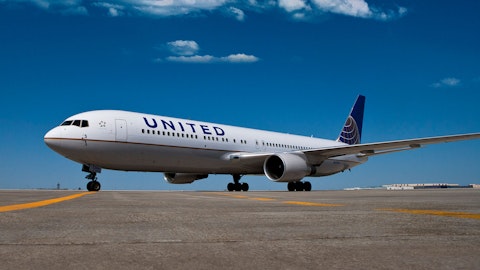United Airlines Holdings, Inc. (NASDAQ:UAL) Q2 2023 Earnings Call Transcript July 20, 2023
Operator: Good morning and welcome to United Airlines Holdings Earnings Conference Call for the Second Quarter 2023. My name is Silas and I will be your conference facilitator today. Following the initial remarks from management, we will open the lines for questions. [Operator Instructions] This call is being recorded and is copyrighted. Please note that no portion of the call may be recorded, transcribed, or rebroadcast without the company’s permission. Your participation implies your consent to our recording of this call. If you do not agree with these terms, simply drop off the line. I will now turn the presentation over to your host for today’s call, Kristina Munoz, Director of Investor Relations. Please go ahead.
Kristina Munoz: Thank you, Silas. Good morning, everyone, and welcome to United’s second quarter 2023 earnings conference call. Yesterday, we issued our earnings release, which is available on our website at ir.united.com. Information in yesterday’s release and the remarks made during this conference call may contain forward-looking statements, which represent the company’s current expectations or beliefs concerning future events and financial performance. All forward-looking statements are based upon information currently available to the company. A number of factors could cause actual results to differ materially from our current expectations. Please refer to our earnings release, Form 10-K and 10-Q and other reports filed with the SEC by United Airlines Holdings and United Airlines for a more thorough description of these factors.
Unless otherwise noted, we will be discussing our financial metrics on a non-GAAP basis on this call. Please refer to the related definitions and reconciliations in our press release. For a reconciliation of these non-GAAP measures to the most directly comparable GAAP measures, please refer to the tables at the end of our earnings release. Joining us on the call today to discuss our results and outlook are Chief Executive Officer, Scott Kirby; President, Brett Hart; Executive Vice President and Chief Commercial Officer, Andrew Nocella; and Executive Vice President and Chief Financial Officer, Gerry Laderman. In addition, we have other members of the executive team on the line available to assist with the Q&A. And now, I’d like to turn the call over to Scott.
Scott Kirby: Thank you, Kristina, and thanks to everyone for joining us this morning. Before I discuss our financial performance for the second quarter, I’d like to first address the operational challenges at Newark at the end of last month. I am extremely proud of the people of United for all they did to recover under very challenging circumstances. Our pilots, flight attendants, gate agents, contact center teams and others went above and beyond to inform and assist our customers in an extremely stressful situation. We are now doing more than ever to mitigate the impact of weather, congestion and other infrastructure constraints at Newark, and frankly, to build a schedule at Newark is more manageable given the frequency of weather events and the very real operating constraints that exist there even on blue sky day.
Brett will highlight just a few of those changes shortly. But we have already put them in motion, we’ve already starting to improve the working experience for our people and travel experience for our customers. A bigger picture, this quarter was yet another proof point that our United Next strategy was correct and is working almost exactly as we expected. Over the past couple of years, I’ve talked a lot about three exogenous constraints facing the industry. But also the fact that those very constraints and challenges are going to set the table for improved financial results for the airline industry. One, pilot shortages; two, supply chain disruptions; and three, infrastructure limitations. At United, we have control over the first two constraints, pilot and supply chain, and we mostly got ahead of the curve and had minimal issues there.
But we’re probably as exposed or the most exposed to the infrastructure constraint since our hubs are in some of the largest and most crowded airports in the country. So now we’re taking even more action to give us the ability to operate more reliably despite the infrastructure constraints. That means we’ve had to lower our capacity plans for the second half and therefore, raised our CASM-ex guidance. But the reality is that our CASM-ex will be better than it otherwise would have been because there’s nothing as expensive as running an off-schedule operation and these changes are designed to get our operations, particularly at Newark, working at a level that reflects the fact that it only has one set of parallel runway operating in the most crowded airspace in the world.
The flip side of this coin, however, is that these exogenous constraints were also the basis of our United Next strategy, and it is off to an incredible even record setting start. This was an all-time record quarter for pretax earnings and EPS on an adjusted basis. This performance reflects our success in building a strategy to, one, aggressively hire pilots; two, grow our Mid-Con hubs; three, upgauge our domestic fleet; and four, expand our wide-body fleet and international exposure in response to the trends that we identified at the beginning of COVID. Importantly, we now expect to deliver earnings per share of $11 to $12, even with incremental conservatism in our cost in the back half of the year. The vision and strategic outlook that we first identified nearly three years ago is happening.
Cost convergence is happening, which has changed our business dramatically on the domestic front. Long term, positive structural changes to the international markets are also apparent in our results. We continue to anticipate that the GDP relationship between airline revenues has been reset higher due to cost conversions and will continue to improve. The outlook for United and our United Next strategy is incredibly bright, as highlighted by our financial results this quarter. This quarter demonstrates that we’re ahead of our planned targets and the challenges to emphasize that the industry backdrop gives us a clear path to our 14% pretax margin in 2026. As we march towards that goal, we’re focused on setting the airline up for success. I’m also pleased that we’ve reached an agreement on an industry-leading contract with ALPA.
The four-year agreement once ratified will deliver a meaningful pay raise and quality of life improvements for our pilots. Thanks to the team for getting this across the finish line. We are well on our way to being the best airline in the history of aviation. United Next gave us an unbeatable head start on that goal as long as we execute and execute we will. Thanks again to the United team. And with that, I’ll turn it over to Brett.
Brett Hart: Thank you, Scott. Thank you to our United team for their hard work this quarter. As Scott mentioned, during the last week of June, we experienced one of the most challenging operational environments in United’s history, impacting primarily our largest international departure hub, Newark. Our hub locations make us disproportionately prone to weather and then in the second quarter, weather was particularly challenging, with 25 major irregular operation days accounting for 75% of our second quarter cancellations. Despite this, we are focused on setting United up for success, and being able to recover more quickly in the future. We are implementing a few new initiatives in Newark that will improve our operation. First, we are reducing the total flying in the peak hours to align better with the capabilities of today’s constrained operating environment.

emiel-molenaar-JOrUKpuMOeU-unsplash
Second, we expect to have additional gating as we bring the remaining six gates in Terminal A online, two of which are additional wide-body gates as well as make additional tactical changes at United. Third, we are adjusting our schedules to increase our out-and-back flying to limit the downline system impact of any cancellations or delays. Fourth, we are increasing our resources and crew scheduling and accelerating the timeline of our technology enhancements and automation. Lastly and importantly, our partnerships with the FAA and Port Authority are essential to the airline’s success. Collaboration and communication amongst these groups has never been stronger. To that end, Scott and our government affairs team continue to remain actively engaged in working with the administration and leaders in Congress to pass an FAA reauthorization bill.
Legislation that equips the FAA with the resources, tools and funding they need isn’t just essential to the success of our industry, it’s among the best investments that we could make for the traveling public in the U.S. economy right now. And we’re committed to continuing to advocate for a smart FAA reauthorization bill and to get it passed quickly. These are only a few of the initiatives underway, but combined with lower capacity, these adjustments add approximately 1 to 2 points of incremental year-over-year pressure to our 2023 CASM-ex. Gerry will go into more detail. But running a successful and efficient airline is critical and United is laser-focused on getting our customers to their destinations safely and on time. As we work to respond to these challenges, we are also investing in our customer experience.
Recently, we announced new mobile app features that support our customers during travel disruptions. These first-of-their-kind tools will allow customers to rebook, track their bags and get meal and hotel vouchers when eligible on their personal device. It is important for us to provide our customers the resources they need for flight or their flight at their fingertips, especially when things don’t go as planned. As Scott mentioned, over the weekend, we reached a tentative agreement with our pilots represented by ALPA. We’re thankful for the hard work our pilots put in every day, and this agreement is a representation of that. We are still in active negotiations with our flight attendants represented by the AFA, and have new agreements in place for all other work groups.
The United team continues to be resilient. We’re making real-time changes that directly impact the travel experience for our customers and for our employees, day-to-day. Proud to be a member of this team. I want to thank everyone for their unwavering hard work. And with that, I’ll pass it over to Andrew to discuss the revenue graph.
Andrew Nocella: Thanks, Brett. I’d like to start off today by thanking the entire United team for their hard work and dedication in taking care of our customers, particularly during the final week of the quarter. Our financial results provide proof that our United Next plans are working and that the demand environment remains robust. United finished the second quarter with top line record quarterly revenues of [$14.2 billion]. Total revenues in the quarter were up 17%, ahead of our guidance of 14% to 16%. June was exceptionally strong and was our best revenue month ever. Since the start of June, we’ve had 13 of our 16 highest flown gross revenue days. TRASM in the quarter was down 0.4% and PRASM was up 2.2% with capacity up 17.5%.
International results were exceptionally strong with passenger revenues up 44% year-over-year. International PRASM increased 13.3% year-over-year. Year-over-year PRASM results were strongest in the Pacific followed by the Atlantic and then Latin America. The resurgence of the United Pacific entity has been the most transformative. Margins for our global long-haul flying continued to outpace domestic margins. Our second quarter capacity deployment plans leaned in international flying with 27% more capacity year-over-year, which proved advantageous. International ASMs represent 45.4% of United’s 2Q capacity, up 2 points from 2019. Domestic passenger revenues were up 7.8% on 10.5% more capacity year-over-year, largely in line with our expectations at the start of the quarter.
Domestic PRASM was down 2.4%, but that was a fantastic outcome as it compares to an exceptionally strong Q2 of ’22. We expect similar or slightly better results for domestic PRASM in the third quarter. Our RM setup for the quarter proved to be the right one. We held back seats early in the booking curve, saving them for higher yields and closing bookings, and we ended the quarter with record top line results. The business recovery remained stable. Revenue from international travelers flying for business grew 40% year-over-year, with 10% growth in the — on domestic business travelers. On a ticketed basis, business travel revenue continues to trend roughly flat to 2019. Cargo revenues have normalized post pandemic. Yields were down 38% versus 2022, but do remain up 29% versus ’19.
We expect yields in the third quarter to be consistent with Q2. Healthy cargo revenues and yields are helping drive incremental profitability to our global long-haul flying. MileagePlus had another strong quarter with revenue up 11% year-over-year. We broke records this quarter for all key measurements from new card acquisitions to new member enrollment. Ancillary revenue from bags and seats hit a record $1 billion in Q2, up 19% year-over-year. Per passenger ancillary revenue increased 8% to $23.79. Replacement of single class RJs with mainline aircraft with multiple types of seat upgrade opportunities is a key driver of our revenue growth. Premium leisure demand remains very strong across the board. Our domestic first class capacity is up 4% from 2019, but RASM growth in that cabin is 12 points stronger than the main cabin even with corporate traffic not fully recovered.
Our global long-haul Polaris product is also offsetting the loss of corporate business revenue with premium leisure demand and validates the size of our Polaris cabins post-pandemic are correct for United hubs. For Q3, we expect the total revenue will be up 10% to 13% year-over-year with capacity up approximately 16%. The demand environment remains strong, and September and October looked particularly strong relative to both 2019 and July and August. Another sign that seasonality has changed in the summer peak period is more spread out relative to the past. Once again, Q3 capacity deployment focuses on international markets with capacity expected to be up 23% versus 13% for domestic. We believe international revenue will continue to outperform domestic revenue in the third quarter across the globe other than Latin America.
Overall, our domestic margins are now back to 2019 levels while our international margins are trending well above where they were in ’19. Earlier this week, we announced an expansion of our Pacific flying this fall with new nonstop service from Manila to San Francisco. We also announced a second daily flight from San Francisco to Taipei, a new daily nonstop flight from Los Angeles to Hong Kong and will resume our service between Los Angeles and Narita as planned. These additions to our key Pacific destinations are in addition to our previously announced expansion plan to the South Pacific. While international flying remains our focus, we also have plans to improve domestic margins by rebuilding and enhancing connectivity versus 2019, grow and engage faster than any other carrier and staying focus on our existing set of hubs.
Domestic connectivity fell materially in the pandemic because we decided to retire about 300 regional jets. But our connectivity is growing every month as we take United Next deliveries, and that will continue to drive PRASM higher each month. Like the period from 2017 to 2019 when we grew RASM and margins by growing connectivity, we’ll do it once again but this time with large mainland jets preferred by our customers. Gauge has also been a key gap and opportunity for United, larger gauge narrow-bodies with 190 or more seats operate with the best single line aisle margins in North America. The introduction of the A321 and MAX 10 were always a key enabler of our United Next age growth and margin growth. The potential of these larger jets is proven and further upside to United Airlines when we finally enter the fleet.
I also want to add to Scott and Brett’s comments about Newark and our United Next plans. United Next always contemplated that the only way to grow Newark was upgauging from regional to mainline flying. We expected that to lead to higher growth in seats and ASM at Newark even though the total number of flights would not be growing. Our growth in Newark has always been contingent upon larger aircraft, not more aircraft. While we need to cut departures — while, may need a couple departures more than planned, we don’t believe these changes will impact our long-term capacity from Newark due to the use of larger gauge aircraft. And with that, I will turn it over to Gerry to talk about our financial results. Gerry?
Gerry Laderman: Thanks, Andrew, and good morning, everyone. I am pleased to report that for the second quarter, we delivered the highest quarterly pretax earnings in the United’s history of $2.2 billion. Our earnings per share of $5.03 was also an all-time record. And in addition, we produced a record second quarter pretax margin of 15.3%, 3 points higher than second quarter of 2019 and ahead of our expectations. This exceptional performance was driven by stronger-than-expected revenue and lower-than-expected fuel prices. The severe weather at the end of June, which drove multiple consecutive days of strained operations, did lead to a 1 point reduction in capacity for the quarter. We also incurred incremental disruption related costs that weren’t anticipated at the time of our guidance.
The capacity loss and added costs led to a CASM-ex impact of approximately 1.5 points for the quarter. Excluding this impact, until June 24, we were trending below the midpoint of our CASM-ex range for the quarter, an indication that our core costs remain under control. And for the rest of the year, the operational and scheduling changes that Brett discussed have reduced our full year capacity plans from our prior expectations, and we now expect full year capacity to be up approximately 18% versus 2022. Additionally, our CASM-ex guidance now incorporates an expectation of additional incremental costs in order to address the operational challenges. Specifically, for the third quarter, we expect CASM-ex to be up 2% to 3% with capacity up approximately 16%, both versus the third quarter of last year.
When combined with our results for the second quarter and our expectations for the fourth quarter, we now anticipate our full-year CASM-ex to be up approximately 1% to 2% versus last year. However, just like the second quarter, outside of the revisions I discussed, our core costs for the rest of the year are trending as expected. Furthermore, our CASM-ex expectation for the year continues to include the impact of our recently announced agreement with our pilots. Turning to earnings. The strong revenue environment and moderate fuel prices continue to provide strength to our bottom line. For the third quarter, we expect earnings per share to be $3.85 to $4.35, with a fuel price of $2.50 to $2.80. More importantly, given our second quarter performance and third quarter outlook, we are raising our full year earnings per share expectation to the top half of our previous guidance range of $10 to $12.
On fleet, we took delivery of 20 Boeing 737 MAX aircraft in the second quarter and paid for 10 of those aircraft with cash. We expect to take delivery of 28 737 MAX aircraft in the third quarter and also look forward to our first Airbus A321neo later this fall. We continue to expect our full year adjusted capital expenditures to be approximately $8.5 billion. Turning to the balance sheet. We ended the quarter with $21 billion in liquidity, including our undrawn revolver. We are comfortable with our current level of liquidity, particularly given the uncertain macroeconomic backdrop. In the second quarter, we opportunistically issued $1.3 billion of enhanced equipment trust certificates secured by a pool of recently delivered Boeing MAX aircraft with an interest rate of 5.8% which was attractive in the current interest rate environment.
Additionally, we prepaid $1 billion of floating rate debt, which carried a current coupon of over 9%. Our adjusted net debt is now down almost $3 billion since the end of 2022 and $6 billion since the end of 2021. With the reduction in debt and the improvement in earnings, at the end of the second quarter, our trailing 12-month adjusted net debt-to-EBITDAR ratio improved by a full turn to 2.4x versus the end of the first quarter, putting us back to where we were prior to the pandemic and ahead of pace to achieve our target of less than 3x by the end of 2023. We also continue to expect to generate positive free cash flow for the full year, including the impact of our new pilot agreement. In conclusion, we are encouraged by the trends we are seeing and believe we’re adequately mitigated against additional operational risk in the back half of the year.
I’m extremely proud of the United team for delivering our strong financial results. Six months ago, when we first announced our full year EPS guidance, we were met with skepticism from some of you listening. Now more than halfway through the year, as we increase our EPS guidance, I hope all of you are as comfortable as we are with the value of the United Next plan, where we continue to march towards meeting our long-term path target in delivering for our customers, employees and shareholders. And with that, I will turn it over to Kristina to start the Q&A.
A – Kristina Munoz: Thank you, Gerry. We will now take questions from the analyst community. Please limit yourself to one question and if needed, one follow-up question. Silas, please describe the procedure to ask a question.
See also 20 Countries With The Highest Rate Of Diabetes and 6 Most Flirtatious Zodiac Signs.
Q&A Session
Follow United Airlines Holdings Inc. (NYSE:UAL)
Follow United Airlines Holdings Inc. (NYSE:UAL)
Operator: [Operator Instructions] The first question comes from Dave Vernon from Bernstein.
David Vernon : So Scott and Gerry, maybe a bigger picture level question for you. We’re kind of coming up to $11 to $12 in earnings this year, can you help point out the two or three things that are unique to your strategy that are going to make it possible to kind of grow from that level? And there’s a lot of concern about domestic slowing down. There’s a concern about peak earnings. I’m just wondering how do we think about sustaining this level of earnings power or even building on it on a one or two-year view, conceptually? Not trying to get guidance for ’24. Just trying to think about conceptually what’s going to help us kind of build from these record levels of profitability.
Scott Kirby : I guess I’ll start and maybe let Andrew give you some details to follow. But at its core, two to three years ago, we started describing United Next, we started describing the intellectual framework for United Next, what we thought was going to change in the industry. And in particular, we thought that the international market was going to be really, really good because we thought demand would recover. And we were literally the only large airline in the world that decided to keep all our airplanes and actually took more airplanes during the pandemic and grow. That has, in fact, happened. Domestically, we thought that the cost convergence was likely to happen. One, because of inflation, we probably think that two or three years ago, about 18 months ago, we thought that, that inflation was going to drive cost convergence and that the expectations for capacity were going to be unfulfilled because supply chain constraints, pilot shortages and infrastructure constraints.
And to fix that particular issue, all three of those things have to come together. It’s not enough if you get the supply chain remedied. It’s not enough to get pilots remedied. All three of them have to happen. And so kind of from a big picture level, like this is playing out exactly like we thought it would. And it’s a fair question. We get the question we’ve gotten into at least six or seven quarters in a row. And the results just keep getting better because the industry backdrop is getting better, particularly for large airlines that have international exposure and they are at the top of the food chain for hiring pilots and for supply chain issue, which is where United sits. And you further that with United — so that’s the industry backdrop.
But United specifically thought this was going to happen, and we made a really big bet on this happening. And the truth is we’re the only ones in the world to do that. While everyone else was shrinking and retiring airplanes, we started betting on the growth and getting ready for United Next. And we thought it would play out like this. It is playing out like this. I really am confident that our margins are set to grow 1 to 2 points a year for each of the next — at least through 2026, and that this is the new normal. Andrew?





